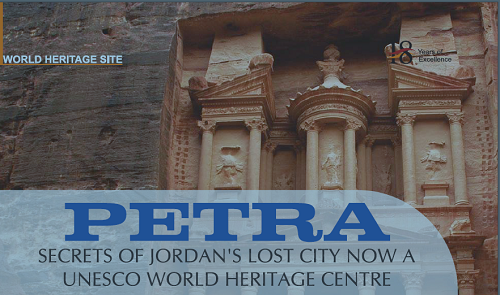PETRA: SECRETS OF JORDAN'S LOST CITY NOW A UNESCO WORLD HER
 Author: STC
Author: STC
Article Date: 01.01.2016
Established probably as early as 312 BC as the capital city of the Arab Nabataeans, it is a symbol of Jordan. And lrecomes Jordan's most-visited tourist attraction. It lies on the slope of Jebel al-Madhbah (identified by some as the biblical Mount Hor) in a basin among the mountains which form the eastern flank of Arabah (Wadi Araba), the large valley running from the Dead Sea to the Gulf of Aqaba. Petra has been a UNESCO World Heritage Site since 1985.
The site remained unknown to the western world until 1812, when it was introduced by Swiss explorer Johann Ludwig Burckhardt. It was described as "a rose-red city half as old as time" in a Newdigate Prize-winning poem by John William Burgon. UNESCO has described it as "one of the most precious cultural properties of man's cultural heritage".
Situated between the Red Sea and the Dead Sea and inhabited since prehistoric times, the rock-cut capital city of the Nabateans, became during Hellenistic and Roman times a major caravan centre for the incense of Arabia, the silks of China and the spices of India, a crossroads between Arabia, Egypt and Syria-Phoenicia. Petra is half-built, half-carved into the rock, and is surrounded by mountains riddled with passages and gorges. An ingenious water management system allowed extensive settlement of an essentially arid area during the Nabataean, Roman and Byzantine periods. It is one of the world's richest and largest archaeological sites set in a dominating red sandstone landscape.
The Outstanding Universal Value of Petra resides in the vast extent of elaborate tomb and temple architecture; religious high places; the remnant channels, tunnels and diversion dams that combined with a vast network of cisterns and reservoirs which controlled and conserved seasonal rains, and the extensive archaeological remains including of copper mining, temples, churches and other public buildings. The fusion of Hellenistic architectural facades with traditional Nabataean rock-cut temple/tombs including the Khasneh, the Urn Tomb, the Palace Tomb, the Corinthian Tomb and the Deir ("monastery") represents a unique artistic achievement and an outstanding architectural ensemble of the first centuries BC to AD. The varied archaeological remains and architectural monuments from prehistoric times to the medieval periods bear exceptional testimony to the now lost civilisations which succeeded each other at the site.
Integrity
All the main free standing and rock-cut monuments and extensive archaeological remains within the arid landscape of red sandstone cliffs and gorges lie within the boundaries of the property that coincide with the boundaries of the Petra National Park. The monuments are subject to ongoing erosion due to wind and rain, exacerbated in the past by windblown sand due to grazing animals reducing ground cover. The resettlement more than twenty years ago of the Bdul (Bedouin) tribe and their livestock away from their former seasonal dwellings in the Petra basin to a new village at Umm Sayhun was aimed in part at arresting this process.
They are also vulnerable to flash flooding along Wadi Musa through the winding gorge (Siq) if the Nabataean diversion system is not continually monitored, repaired and maintained.
The property is under pressure from tourism, which has increased greatly since the time of inscription, particularly congestion points such as the Siq which is the main entrance to the city from the east.
Authenticity
The attributes of temple/tomb monuments, and their location and setting clearly express the Outstanding Universal Value. The natural decay of the sandstone architecture threatens the authenticity of the property in the long-term. Stabilization of freestanding monuments including the Qasr al Bint temple and the vaulted structure supporting the Byzantine forecourt to the Urn Tomb Church was carried out prior to inscription.
Protection and management requirements
Under Jordanian National law, responsibility for protection of Antiquities sites lies with the Department of Antiquities, a separate entity under the Ministry for Tourism and Antiquities.
The property is a protected area within the Petra Archaeological Park managed by the Ministry of Tourism and Antiquities. However responsibility for the overall planning and implementation of infrastructure projects at the site rests largely with the Petra Regional Authority (PRA) - originally the Petra Regional Planning Council (PRPC) - but now expanded to cover the social and economic wellbeing of the communities in the locality.